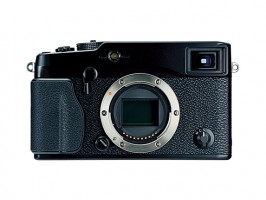 FUJIFILM North America Corporation introduced the FUJIFILM X-Pro1 interchangeable lens digital camera system at CES today. Three technological advances make this camera interesting not only for still photographers but also for cinematographers and the people who design motion picture cameras.
FUJIFILM North America Corporation introduced the FUJIFILM X-Pro1 interchangeable lens digital camera system at CES today. Three technological advances make this camera interesting not only for still photographers but also for cinematographers and the people who design motion picture cameras.
1. CMOS Sensor without low-pass filter
Fujifilm has developed a new CMOS sensor called the X-Trans CMOS. It does not need an optical low-pass filter. The new color filter array is inspired by the random arrangement of fine film grain, removing the need for an optical low-pass filter to solve moiré and false color issues.
In the array, RGB pixels are arranged in 6×6 pixel sets with high aperiodicity (randomness). Increasing the degree of randomness eliminates the fundamental cause of moiré and false colors – a problem that occurs in conventional arrays when shooting stripes and other repeating patterns. The presence of an R, G and B pixel in every vertical and horizontal pixel series minimizes the generation of false colors and delivers higher color reproduction. Furthermore, the absence of optical low-pass filter improves resolution.
As a result of using a film-inspired array, a more powerful processor was required to process the image signal data. So Fujifilm has developed the EXR Processor Pro for high speed and high precision image processing.
Cine cameras will benefit from this low-passless technology. I’m reminded of the P+S TECHNIK PRO35 Image Converter that used an oscillating ground glass to capture video images with 35mm format lenses. The random pattern of the moving grains gave a film-like look to the video images.
2. Hybrid Multi Viewfinder
First introduced in FUJIFILM’s X100 digital camera, the X-Pro1 Hybrid Viewfinder has the ability to instantly switch between an Optical Viewfinder and Electronic Viewfinder. For the brightest viewing image, and to keep shutter lag to a minimum, users should choose the Optical Viewfinder. Those wanting focus confirmation, exposure information, white balance information and depth of field indicators should switch to the Electronic Viewfinder.
The Electronic Viewfinder provides a “Live View” of your composition. This fusion of technologies allows “Leica-like” composing of images through a bright rangefinder viewfinder, and also has the option to overlay vital picture taking information should this be required.
Changing between the two viewfinders is simple, thanks to the switch on the front of the X-Pro1 body. When attaching a FUJINON XF-series lens on the X-Pro1, both the viewfinder magnification and bright frame size automatically switch to support the lens focal length. Viewfinder magnification switches to 0.37x for the 18mm lens, and to 0.60x when the 35mm or 60mm lens is mounted, letting you compose your shot with the bright, crystal clarity of an optical image. The X-Pro1 also lets you manually set a focal distance and switch between viewfinder magnifications.
Someday cine cameras will use hybrid viewfinders, I think.
3. FUJIFILM X-Mount
Flange focal depth is getter shorter. This allows lenses to be designed that are smaller, lighter, faster, less expensive. Specifically designed to take advantage of the mirrorless design of the X-Pro1 body, the X-Mount has a short flange-to-image-plane distance of 17.7mm.
I can hear the CNC machines revving up in Munich, LA, London and elsewhere. P+S TECHNIK, 16×9 Inc, Hot Rod Cameras, Denz, Mike Tapa, Peter Denz, Alfred Piffl, Ken Robings are all surely yearning for this camera as a wonderful platform onto which to fabricate PL to X-Mount adaptors–to be used as directors finders, lens test cameras, and PL still cameras.
What does this mean for the motion picture market? Shorter flange focal depths in the future.
Specs
Complete camera specs are available online on Fujifilm’s X-Pro1 Website.
The FUJIFILM X-Pro1 will be available in February 2012, and the price will be announced in late January 2012.








